On Thursday 16th November 2017, I attended the Rail Research UK Association (RRUKA) Annual Conference in London. After transfer to Wolverhampton station by car, I caught the 06:04 Virgin service to Euston. At that time of the morning, there wasn't much to see on the way down but I'm happy to report the train arrived on time.
I'd decided to walk to the venue at Kings Place (gritting my teeth that the location chooses not to use an apostrophe in spelling its name). I walked east along Euston Road, past St. Pancras to King's Cross station.
King's Cross Station
Having a little time in hand, I briefly examined the new and old concourses at the station, which sometimes uses an apostrophe in the name, sometimes not. I tend to be similarly inconsistent (depending how 'modernist' I'm feeling). I'm not a fan of the new concourse with its 'alien beanstalk' roof framing dominating the space.

King's Cross Station: The 'New' concourse illuminated.
But I've always had a soft spot for Cubitt's compact train shed at this terminus, unobtrusively but effectively carrying out its function.
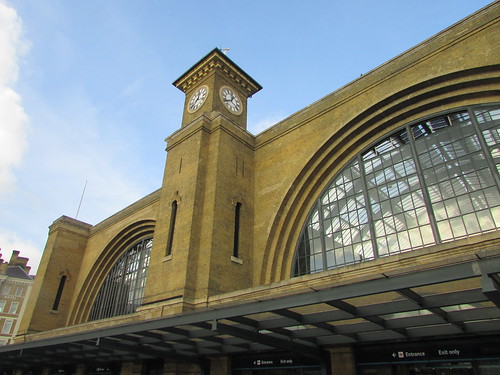
King's Cross Station: The simple but elegant end of the train shed is revealed.
Although I'm sure my long-suffering mother took me to look at King's Cross when I was a child, it was probably not until around 1974 that I became a regular visitor when my firm, Ford Electronics, supplied and installed an Electrification Telephone System for 100 route-kilometres of electrified railway on the Great Northern Line (briefly described here). My most unusual journey from King's Cross came in 2005 when, in connection with TPWS development, I travelled on a Class 373 Test Train from King's Cross to Grantham, described here. Somewhat later, Ford Electronics also modernised an aging British Rail-designed Tunnel Telephone system serving the Northern City line to Moorgate. Since the Moorgate line was actually controlled from King's Cross Power Box, special interface equipment was installed, and I became quite familiar with the Power Box over the years.

King's Cross Power Box: General view of operating floor in 2002.
'Related posts' below leads you to earlier mentions of King's Cross in this blog.
After my brief tour, I turned the south-east corner of the station building into York Way and, for the first time, noticed some modern steel bracing which had been added to Lewis Cubitt's venerable wall. One of the braces was in front of a Boundary Stone set in the brickwork and appeared to have cracked the face of the stone but I still found it a fascinating relic.

King's Cross Station: Insensitive bracing added to the SE corner of Cubitt's station building has virtually destroyed this boundary stone.
Origins of RRUKA
In 1993 state-owned British Rail was privatised with control of the infrastructure (and responsibility for safety and standards) passing to privatised Railtrack. Railtrack collapsed in 2001, resulting in the creation of a new body in 2003, the Rail Safety and Standards Board (RSSB) as an independent not-for-profit company limited by guarantee. Since then, a host of initiatives have been created (leading to an 'alphabet soup' of acronyms such as SPARK, CIRAS, SMIS+ and RRUKA). The Rail Research UK Association (RRUKA) was established in 2010 with core funding provided by RSSB, to form a partnership between the British rail industry and UK universities. Each year, there is a conference, currently held at Kings Place, London.
The venue
Kings Place is a modern building on the opposite side of York Way from King's Cross Power Box, mentioned above, just a few yards further north. The website here invites visitors to "Come and experience two world-class concert halls, purpose-built art galleries, a bar/café, waterside restaurant and award winning conference and events facilities - all under one roof." Although I tend to dislike modern architecture, Kings Place is thoughtfully laid out and appears to carry out its remit well. All the arrangements worked well throughout the day and I ended up fairly impressed.
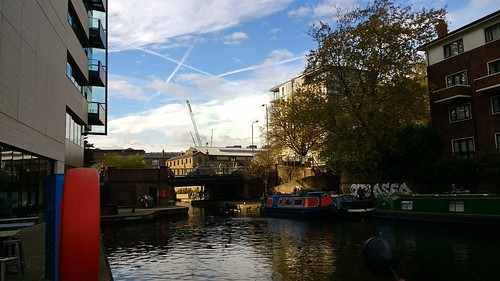
London: The Regent's Canal at Kings Place, looking towards York Way and Maiden Lane Bridge.
The event
Registration was quickly completed in the Music Foyer on the Lower Ground Floor where numerous polite and friendly staff were on hand to dispense beverages.
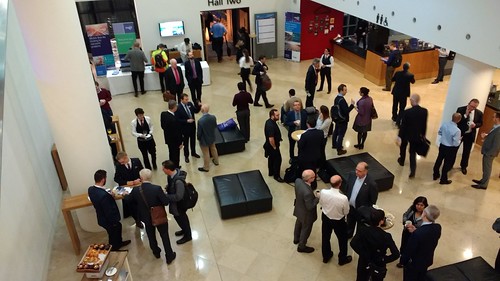
RRUKA Annual Conference 2017, Kings Place, London: Registration and beverages.
On time, delegates moved to the adjacent Hall 2 for the event itself. Hall 2 was equipped with effective audio-visual facilities (incorporating a Yamaha digital live-sound mixing console M7CL), theatre-style lighting and reasonably comfortable individual chairs.

RRUKA Annual Conference 2017, Kings Place, London: Hall 2 showing lighting arrangements and computer projector.
After opening remarks by Luisa Moisio (R&D Programme Director RSSB), the Keynote Address was given by Marco Caposciutto (Technical Director Trenitalia) and Ernesto Sicilia (Chairman /M.D. Trenitalia). This was followed by a review of research partnerships by Luisa Moisio and Sharon Odetunde (Head of Academic Partnerships RSSB). Next, there were two research presentations on 'Time spent by passengers at stations' and 'Benefits of mechatronically-guided vehicles on railway track switches', terminating in a short question-and-answer session.
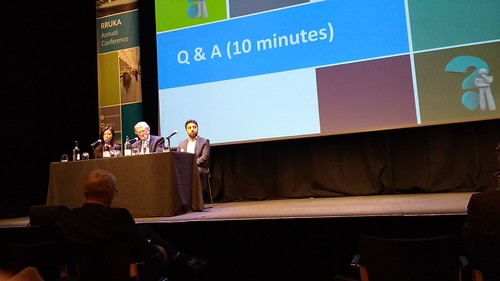
RRUKA Annual Conference 2017, Kings Place, London: One of the Question and Answer sessions.
There was then an opportunity to visit the 'Blue-Sky Village' exhibition in the Battlebridge Room, where refreshments were served.
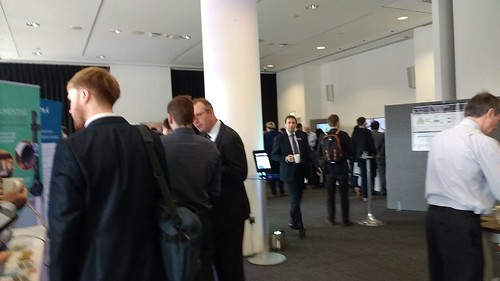
RRUKA Annual Conference 2017, Kings Place, London: The 'Blue-Sky Village'.
The morning session continued in Hall 2 with three research presentations covering automated servicing of passenger train fluids, a cab front cleaning robot and robotic systems for wheelset reworking, followed by questions and answers. The morning session concluded with three 'elevator pitches' for future studies.
A buffet lunch (with a choice of three 'mains') was served in the Battlebridge Room, giving ample opportunity to talk to the exhibitors in the 'Blue-Sky Village'.
At 2.00 p.m., the afternoon session was introduced by Stuart Hillmansen, Senior Lecturer at the University of Birmingham. Three more 'elevator pitches' were followed by two research case studies on the SmartDrive Project and the integration of real-time performance measurement with simulation. The afternoon coffee break offered a final opportunity to study the displays in the 'Blue-Sky Village'.
Iain Roche (Head of Innovation HS2) then gave the afternoon Keynote Address. The formal business of the day concluded with the presentation of the RRUKA Best Young Researcher Award and closing remarks by Stuart Hillmansen, after which delegates were invited to a drinks reception in the Music Foyer.
An interesting event, well-organised by RSSB and RRUKA.
Related posts on this website
Electrification Telephone Systems for British Rail.
London's Terminal Stations.
Redevelopment at King's Cross Station.
Class 373 Test Train to Grantham.
My photograph albums
Where necessary, clicking on an image above will display an 'uncropped' view or, alternately, pictures may be selected, viewed or downloaded, in various sizes, from the albums listed:-
London: King's Cross Station.
Kings Cross Power Box.
RRUKA Annual Conference 2017.
